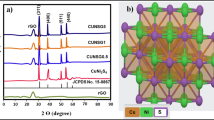Abstract
The CuS@reduced graphene oxide (CuS/RGO) hybrid nanocomposite was synthesized by facile hydrothermal method and used as a photoelectrode material in photovoltaic applications. In the hydrothermal route, RGO is formed by the reduction of GO with simultaneous formation of CuS/RGO nanocomposites. The CuS/RGO nanocomposites was investigated using powder XRD, TEM, HR-TEM, Raman, XPS, DRS UV–Vis spectroscopy, Photoluminescence (PL) measurements. XRD and TEM results suggest that CuS crystalline with individual spherical like homogeneous nanoparticles sizes in the range of 45–35 nm, which is distributed throughout the RGO sheets. We further construct the flexible photoelectrodes by using CuS and RGO and studied the photovoltaic performance. Photovoltaic parameters, such as short-circuit photocurrent density, open circuit voltage, fill factor and conversion efficiency were found to be 16 mA/cm2, 0.71 V, 70.1% and 7.81% respectively, for CuS/RGO photoelectrode. The improved photo conversion efficiency of CuS/RGO is due to enhancing the electronic injection ability and reducing the photogenerated charge recombination. These photovoltaic results indicate a simple methodology for the low cost and effortless synthesis of an alternative CuS/RGO photoelectrode in high performance photovoltaic devices.








Similar content being viewed by others
References
L. Suganthi and A. A. Samuel (2012). Renew. Sustain. Energy. Rev.16, 1223.
M. Z. Iqbal and S. Khan (2018). Sol. Energy160, 130.
J. Wu, Z. Lan, J. Lin, M. Huang, Y. Huang, L. Fan, G. Luo, Y. Lin, Y. Xie, and Y. Wei (2017). Chem. Soc. Rev.46, 5975.
M. S. Dresselhaus and I. L. Thomas (2001). Nature414, 332.
M. R. Narayan (2012). Renew. Sustain. Energy Rev.16, 208.
A. V. Shah, R. Platz, and H. Keppner (1995). Sol. Energy Mater Solar Cells38, 501.
A. Hagfeldt, G. Boschloo, L. Sun, L. Kloo, and H. Pettersson (2010). Chem. Rev.110, 6595.
M. Sumathi, A. Prakasam, and P. M. Anbarasan (2019). J. Clust. Sci.30, 757.
M. Yousefi, M. Sabet, M. Salavati-Niasari, and S. M. Hosseinpour-Mashkani (2012). J. Clust. Sci.23, 491.
M. Yousefi, M. Sabet, M. Salavati-Niasari, and H. Emadi (2012). J. Clust. Sci.23, 511.
M. Abdi-Jalebi, M. R. Mohammadi, and D. J. Fray (2014). J. Clust. Sci.25, 1029.
Z. Zarghami, M. Ramezani, and K. Motevalli (2016). J. Clust. Sci.27, 1451.
J. G. Radich, R. Dwyer, and P. V. J. Kamat (2011). Phys. Chem. Lett.2, 2453.
Z. Yang, C. Chen, C. Liu, C. Li, and H. Chang (2011). Adv. Energy Mater.1, 259.
Z. Yang, C. Chen, C. Liu, and H. Chang (2010). Chem. Commun.46, 5485.
Z. Tachan, M. Shalom, I. Hod, S. Ruhle, and S. Tirosh (2011). Zaban. J. Phys. Chem. C115, 6162.
J. Kundu, D. Pradhan, and A. C. S. Appl (2014). Mater. Interfaces.6, 1823.
X. Jiang, Y. Xie, J. Lu, W. He, L. Zhu, and Y. Qian (2010). J. Mater. Chem.10, 2193.
J. S. Chung and H. J. Sohn (2002). J. Power Sources.108, 226.
A. B. F. Martinson, J. W. Elam, and M. J. Pellin (2009). Appl. Phys. Lett.94, 123107.
M. Basu, A. K. Sinha, M. Pradnan, S. Sarkar, Y. Negishi, and T. Pal (2010). Environ. Sci. Technol.44, 6313.
S. Stankovich, D. A. Dikin, G. H. B. Dommett, K. M. Kohlhaas, E. J. Zimney, E. A. Stach, R. D. Piner, S. T. Nguyen, and R. S. Ruoff (2006). Nature.442, 282.
D. A. Brownson and C. E. Banks (2010). Analyst.135, 2768.
W. S. Hummers and R. E. Offeman (1958). J. Am. Chem. Soc.80, 1339.
S. Drewniak, R. Muzyka, A. Stolarczyk, T. Pustelny, M. Kotyczka-Morańska, and M. Setkiewicz (2016). Sensors.16, 103.
M. Parthibavarman, K. Vallalperuman, S. Sathishkumar, M. Durairaj, and K. Thavamani (2014). J. Mater. Sci. Mater. Electron.25, 730.
H. C. Tao, X. L. Yang, L. L. Zhang, and S. B. Ni (2014). J. Phys. Chem. Solids.75, 1205.
L. Fei, Q. L. Lin, B. Yuan, G. Chen, P. Xie, Y. L. Li, Y. Xu, S. G. Deng, S. Smirnov, and H. M. Luo (2013). ACS Appl. Mater. Interfaces.5, 5330.
M. Parthibavarman, S. Sathishkumar, M. Jayashree, and R. BoopathiRaja (2019). J. Clust. Sci.30, 351.
M. Parthibavarman, S. Sathishkumar, S. Prabhakaran, M. Jayashree, and R. BoopathiRaja (2018). J. Iran. Chem. Soc.15, 2789.
J. Zhou, F. Zhao, X. Wang, Z. Li, Y. Zhang, and L. Yang (2006). J. Lumin.237, 237.
X. S. Hu, Y. Shen, Y. T. Zhang, and J. J. Nie (2017). J. Phys. Chem. Solid.103, 201.
M. Saranya, R. Ramachandran, P. Kollu, S. K. Jeong, and A. N. Grace (2015). RSC Adv.5, 15831.
J. Zhao, D. Liu, C. Gu, M. Zhu, S. O. Ryu, and J. Huang (2018). Mater. Chem. Phys.217, 102.
Z. Li, F. Gong, G. Zhou, and Z. S. Wang (2013). J. Phys. Chem. C.117, 6561.
Author information
Authors and Affiliations
Corresponding author
Additional information
Publisher's Note
Springer Nature remains neutral with regard to jurisdictional claims in published maps and institutional affiliations.
Rights and permissions
About this article
Cite this article
Saravanan, K.K., SivaKarthik, P. Ru-Dye Grafted CuS and Reduced Graphene Oxide (CuS/rGO) Composite: An Efficient and Photo Tunable Electrode for Dye Sensitized Solar Cells. J Clust Sci 31, 401–407 (2020). https://doi.org/10.1007/s10876-019-01653-1
Received:
Published:
Issue Date:
DOI: https://doi.org/10.1007/s10876-019-01653-1




